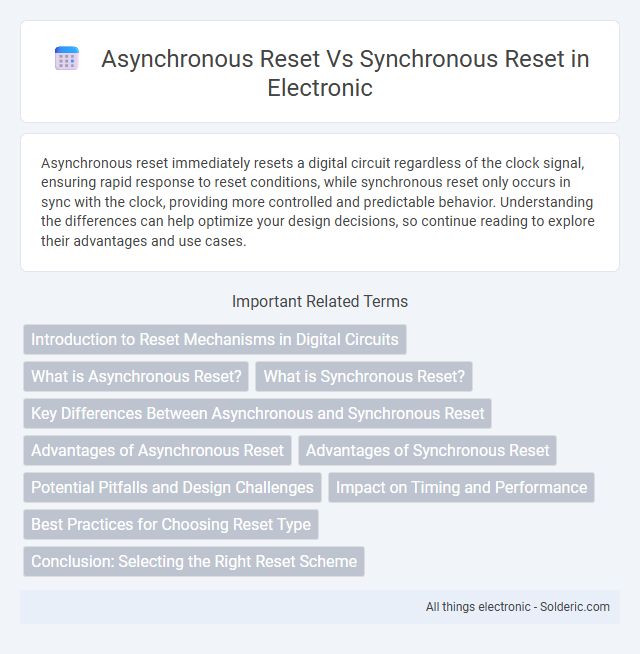Asynchronous reset immediately resets a digital circuit regardless of the clock signal, ensuring rapid response to reset conditions, while synchronous reset only occurs in sync with the clock, providing more controlled and predictable behavior. Understanding the differences can help optimize your design decisions, so continue reading to explore their advantages and use cases.
Comparison Table
| Feature | Asynchronous Reset | Synchronous Reset |
|---|---|---|
| Reset Timing | Independent of clock; immediate reset on assertion | Occurs synchronously with the clock edge |
| Design Complexity | Higher due to potential metastability and reset recovery issues | Lower; easier timing analysis and control |
| Reset Latency | Minimal latency; instant reset | Latency depends on clock period; reset effective after clock edge |
| Glitch Susceptibility | More prone to glitches due to asynchronous nature | Less prone to glitches; reset synchronized with clock |
| Power Consumption | Potentially higher due to asynchronous toggling | Lower; synchronized toggling limits unnecessary transitions |
| Use Cases | Critical immediate reset scenarios; system-level resets | Regular operation resets; easier to implement in synchronous designs |
Introduction to Reset Mechanisms in Digital Circuits
Asynchronous reset instantly forces a digital circuit into a known state regardless of the clock, ensuring immediate system initialization or error recovery. Synchronous reset aligns reset signals with the clock edge, enabling controlled state transitions and reducing the chance of metastability. Your choice between asynchronous and synchronous reset impacts circuit reliability, timing complexity, and overall design robustness.
What is Asynchronous Reset?
Asynchronous reset is a hardware signal that immediately forces a digital circuit, such as a flip-flop or a register, into a predefined state regardless of the clock signal. It operates independently of the clock, enabling instant initialization or clearing of the circuit during any clock phase, which makes it crucial for reliable startup and fault recovery. This type of reset is commonly used in FPGA and ASIC designs to ensure deterministic behavior during power-up or error conditions.
What is Synchronous Reset?
Synchronous reset is a digital circuit design technique where the reset signal is synchronized with the clock signal, ensuring that the reset state only takes effect during the clock's active edge. This method avoids timing glitches and metastability by aligning reset actions with the system clock, making it ideal for synchronous designs. Your circuits benefit from predictable timing and improved reliability when using synchronous reset compared to asynchronous reset.
Key Differences Between Asynchronous and Synchronous Reset
Asynchronous reset instantly clears flip-flop outputs regardless of the clock signal, ensuring immediate response to reset conditions but risking metastability if de-asserted near clock edges. Synchronous reset relies on the clock signal to reset outputs, providing predictable timing and better control within synchronous designs but introducing latency in the reset operation. The choice impacts system reliability, with asynchronous resets favored for rapid recovery and synchronous resets preferred for timing accuracy and design simplicity.
Advantages of Asynchronous Reset
Asynchronous reset allows immediate resetting of a flip-flop regardless of the clock signal, enabling faster response to critical fault conditions. It simplifies the design of emergency stop circuits and improves system reliability by ensuring a known state is achieved promptly. This reset type reduces the risk of metastability during power-up and can be crucial in safety-critical applications.
Advantages of Synchronous Reset
Synchronous reset ensures that the reset signal is aligned with the clock, minimizing potential metastability and glitches in digital circuits. This allows your design to maintain precise timing control, improving reliability during system startup and operation. Implementing synchronous reset simplifies timing analysis and verification, making it the preferred choice in high-speed and complex FPGA or ASIC designs.
Potential Pitfalls and Design Challenges
Asynchronous resets can cause metastability and glitches due to their immediate effect on flip-flops irrespective of the clock, leading to unpredictable behavior during de-assertion and difficulty in timing analysis. Synchronous resets, while easier to integrate within timing constraints, may introduce latency and require careful clock domain considerations to avoid reset release hazards. Designers must address reset synchronization, hold time violations, and verification complexity to ensure reliable system startup and operation.
Impact on Timing and Performance
Asynchronous reset triggers immediately upon assertion, which can cause timing uncertainty and potential metastability, impacting the overall system reliability and speed. Synchronous reset aligns with the clock edge, ensuring predictable timing and minimizing the risk of glitches, but it may introduce latency as the reset is only recognized on the clock cycle. Your choice between asynchronous and synchronous reset directly affects the timing closure and performance trade-offs during FPGA or ASIC design implementation.
Best Practices for Choosing Reset Type
Choosing between asynchronous reset and synchronous reset depends on your design requirements and timing constraints. Asynchronous resets provide immediate response to reset signals, ensuring fast initialization but may introduce metastability or glitches if not properly synchronized with the clock domain. Synchronous resets align with the clock, improving reliability and easier timing closure, making them ideal for complex designs where predictable reset behavior and seamless integration into the clocked logic path are crucial for Your system stability.
Conclusion: Selecting the Right Reset Scheme
Choosing between asynchronous and synchronous reset depends on your system's timing requirements and complexity; asynchronous resets trigger immediately, ideal for fast response but risk metastability, while synchronous resets align with clock edges, ensuring safer state transitions but introduce latency. Your design constraints and reliability needs dictate the optimal reset scheme to balance performance and stability. Careful analysis of timing, reset propagation, and system behavior ensures the right reset choice enhances your circuit's robustness.
asynchronous reset vs synchronous reset Infographic

 solderic.com
solderic.com